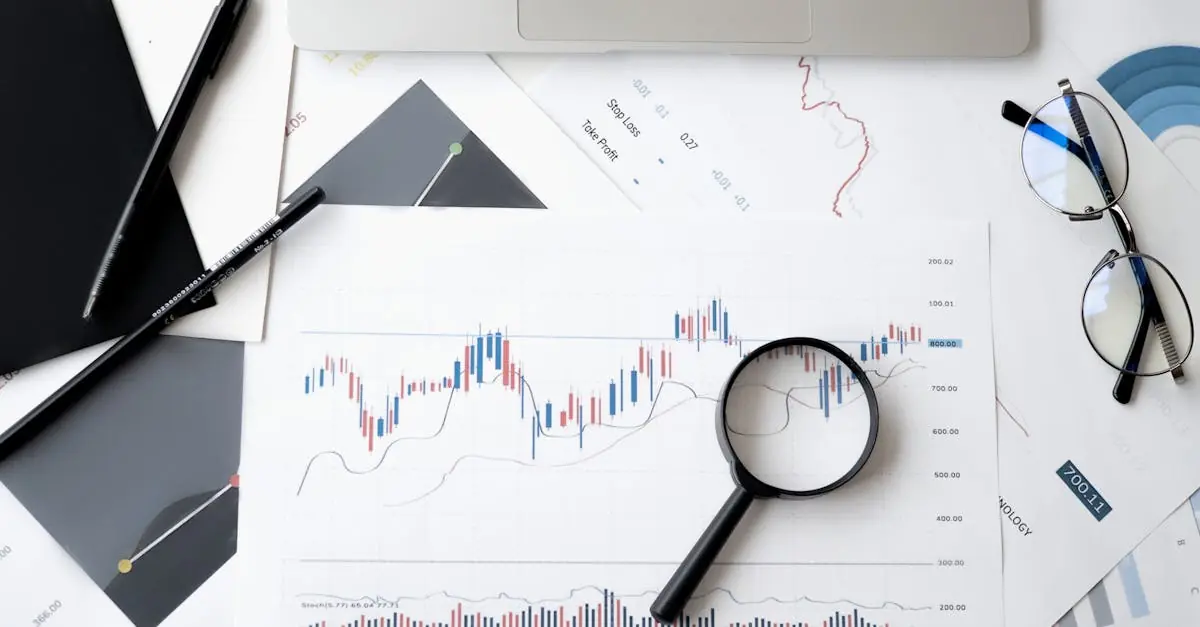Table of Contents
ToggleIn a world where coffee prices seem to rise faster than your morning jitters, understanding macroeconomic trends has never been more crucial. These trends shape everything from your paycheck to the price of that avocado toast you love. If you think it’s just about numbers and graphs, think again—it’s about navigating the wild ride of the global economy with a sense of humor and a dash of savvy.
Overview Of Macro Economic Trends
Understanding macroeconomic trends is crucial for interpreting current market dynamics and their impact on daily life. Rising inflation, for instance, directly influences consumer purchasing power. In 2023, inflation rates reached levels not seen in decades, affecting essential goods and services.
Employment trends reflect shifts in economic health, impacting household income. Low unemployment rates often correspond with increased consumer spending. As businesses expand, job creation typically follows, boosting economic stability.
Global trade patterns further reveal the interconnectedness of economies. Tariffs and trade agreements can alter supply chains, affecting the price of imported goods. For example, recent trade policies shaped the costs of technology imports, leading to higher prices for consumers.
Interest rates set by central banks affect borrowing and spending behaviors. Lowering interest rates usually stimulates investment, while rising rates might dampen economic growth. Mortgage rates, which influence housing markets, often fluctuate based on these policies.
Another significant trend involves technology’s role in economic growth. Automation and digitalization are reshaping industries, impacting productivity and employment. Innovations, such as artificial intelligence, can lead to job displacement in some sectors while creating opportunities in others.
Consumer confidence indexes measure sentiment and predict spending. When confidence rises, spending typically follows, contributing to economic expansion. Understanding these indexes helps gauge future market trends.
Navigating macroeconomic trends requires a grasp of these various factors and their implications. Economic literacy equips individuals with the tools to make informed decisions in an evolving landscape. Adapting to these trends is vital for maintaining financial stability and prosperity.
Key Indicators Of Macro Economic Trends
Understanding key indicators of macroeconomic trends is crucial for interpreting the overall health of an economy. These indicators provide insights into growth, employment, and pricing dynamics.
GDP Growth Rates
GDP growth rates reflect a country’s economic performance. They measure the annual percentage change in the value of all goods and services produced. Positive growth signals economic expansion, while negative growth often indicates recession. Consistent growth above 2% is usually a sign of a healthy economy, encouraging investment and job creation. As GDP rises, increased consumer spending often follows, reinforcing upward economic momentum. Countries monitoring GDP closely can adjust policy measures to maintain stability and growth.
Unemployment Rates
Unemployment rates serve as essential indicators of workforce health. They represent the percentage of the labor force actively seeking employment but unable to find a job. Low unemployment rates typically suggest a thriving economy, promoting consumer confidence and spending. When unemployment dips below 4%, many cite it as full employment. Rising unemployment can signal economic challenges, prompting reactions from policymakers. Tracking trends in unemployment helps gauge the effectiveness of economic strategies and anticipated consumer behavior.
Inflation Trends
Inflation trends indicate the rate at which the general level of prices for goods and services rises. Mild inflation often points to healthy demand, while high inflation erodes purchasing power, impacting daily expenses. Central banks aim for a target inflation rate, generally around 2%, to foster economic stability and growth. When inflation exceeds targets, consumer confidence can wane, affecting spending habits. Observing inflation rates enables businesses and consumers to plan and adapt their financial decisions effectively.
Impact Of Global Events On Macro Economic Trends
Global events significantly shape macroeconomic trends, influencing how economies operate and interact. Understanding these impacts helps anticipate changes in the global marketplace.
Trade Wars
Trade wars, characterized by tariffs and trade barriers, disrupt established trade relationships. Countries involved often face increased costs for imported goods, leading to inflation in domestic markets. For instance, the U.S.-China trade conflict raised tariffs on various products, resulting in higher prices for consumers and businesses alike. Adjustments in supply chains occur as businesses seek to minimize tariff impacts, sometimes relocating production or sourcing materials from different countries. This volatility creates uncertainty in the market, affecting investment decisions and economic growth.
Climate Change
Climate change poses unique challenges to macroeconomic stability. Extreme weather events can damage infrastructure, disrupt supply chains, and affect agricultural output, leading to food shortages and increased prices. Economies reliant on natural resources face additional pressures, as shifts in weather patterns may affect productivity. Green initiatives emerge as responses, stimulating investment in renewable technologies and creating new job markets. Adapting to climate change requires significant financial resources, influencing national budgets and economic policies. Such adaptation efforts often reshape industries and consumer behavior, reinforcing the interconnectedness of environmental and economic trends.
Regional Analysis Of Macro Economic Trends
Understanding regional macroeconomic trends provides valuable insights into global economic dynamics. Each area exhibits unique characteristics that significantly influence local and international markets.
North America
North America’s economy shows resilience through steady GDP growth rates, driven by strong consumer spending. Employment numbers reflect ongoing recovery from past downturns, with low unemployment rates bolstering confidence. Inflation, although present, remains moderate compared to historical highs. Central banks maintain interest rates to encourage borrowing and investment. The technology sector continues to thrive, generating jobs and fostering innovation.
Europe
Europe faces diverse challenges across its member states, with varying inflation rates impacting purchasing power. Key economies like Germany and France drive growth, but some nations struggle with higher unemployment. Trade agreements within the EU help stabilize the region, though external factors, such as Brexit, introduce uncertainties. The European Central Bank influences market conditions through interest rate adjustments, aiming to balance growth and stability.
Asia
Asia’s economic landscape exhibits rapid growth, supported by increasing manufacturing and technology investments. Countries such as China and India play pivotal roles, attracting global businesses and talent. Inflation rates differ significantly, with some nations experiencing pressures from rising commodity prices. Regional trade agreements, like the Regional Comprehensive Economic Partnership, enhance economic collaboration. Consumer confidence appears strong, driving demand and influencing market dynamics.
Future Predictions For Macro Economic Trends
Forecasts indicate that rising inflation will continue to challenge consumer purchasing power in upcoming years. Analysts predict that if inflation rates stabilize, consumer confidence may improve, enhancing overall spending behaviors.
Interest rates are likely to experience fluctuations as central banks respond to economic conditions. Projections show that decreasing interest rates may encourage borrowing, stimulating growth in real estate and personal loans.
Employment statistics reflect optimism, with low unemployment rates expected to persist in developed economies. Job creation in emerging sectors such as technology will support labor markets and boost consumer demand.
Global trade dynamics are anticipated to evolve due to ongoing discussions around trade agreements. New partnerships and shifts in tariffs could reshape supply chains, influencing the prices of imports and exports.
Technology’s role in economic growth will remain significant, especially in addressing challenges like job displacement. Automation and artificial intelligence may create new job opportunities, necessitating upskilling in the workforce.
Weather-related issues linked to climate change pose potential risks to agricultural outputs. Predictions suggest that food prices may rise due to supply chain disruptions, emphasizing the need for adaptable economic strategies.
In North America, expected steady GDP growth will rely heavily on consumer spending and technological advancements. Economic resilience is likely to hinge on low unemployment rates while navigating inflationary pressures.
Europe’s diverse challenges will continue to shape its economic landscape, with varying inflation rates across member states. Central bank policies will play a crucial role in stabilizing economic activity within the region.
Asia will maintain its position as a growth driver, with rapid advancements in technology and manufacturing. Countries like China and India are predicted to lead regional trade agreements, further enhancing collaboration and market strength.
Understanding macroeconomic trends is crucial for anyone looking to navigate today’s complex economic landscape. As inflation continues to rise and global trade dynamics shift, staying informed allows individuals and businesses to make better financial decisions.
Adapting to these trends is essential for maintaining financial stability and prosperity. With evolving employment opportunities and the impact of technology, a proactive approach to economic literacy can empower individuals to thrive despite challenges.
By keeping an eye on key indicators and regional developments, one can better anticipate changes and seize opportunities in an ever-changing economy.




